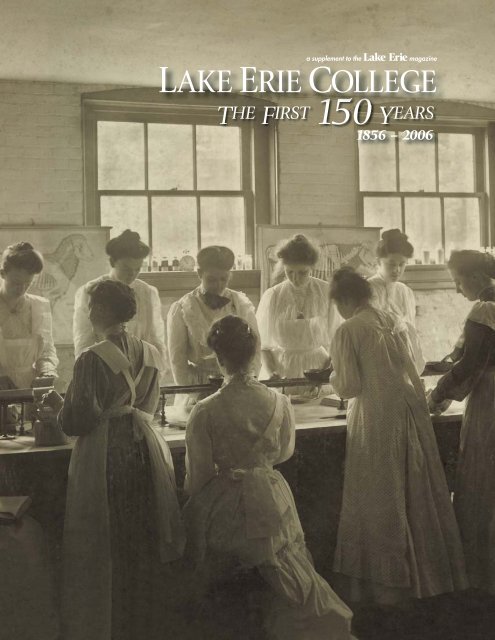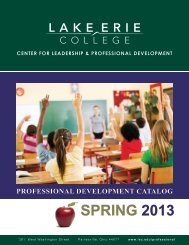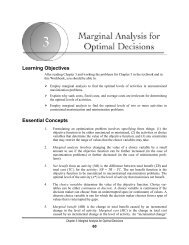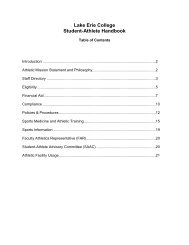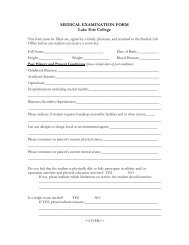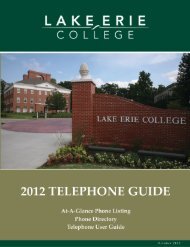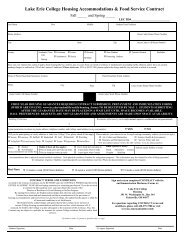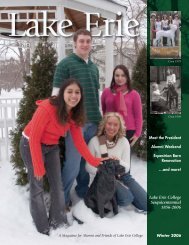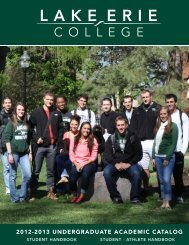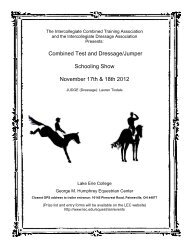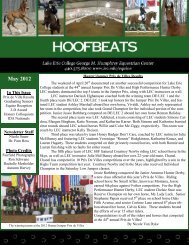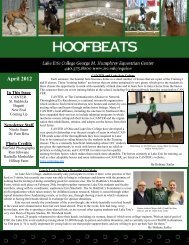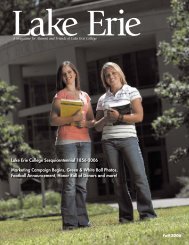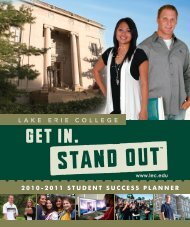Historical Insert: The First 150 Years (PDF) - Lake Erie College
Historical Insert: The First 150 Years (PDF) - Lake Erie College
Historical Insert: The First 150 Years (PDF) - Lake Erie College
Create successful ePaper yourself
Turn your PDF publications into a flip-book with our unique Google optimized e-Paper software.
a supplement to the <strong>Lake</strong> <strong>Erie</strong> magazine<br />
LAKE ERIE COLLEGE<br />
T HE F IRST <strong>150</strong> Y EARS<br />
1856 – 2006
Times have changed. So has<br />
<strong>Lake</strong> <strong>Erie</strong> <strong>College</strong>. As its<br />
Sesquicentennial celebration<br />
draws to a close, the <strong>College</strong><br />
shares the opportunity to look<br />
back and reflect upon its history.<br />
This document is based upon a<br />
review of materials provided from<br />
the <strong>Lake</strong> <strong>Erie</strong> <strong>College</strong> archives,<br />
administrative offices and<br />
“Dancing on the Table,” written<br />
by Margaret Geissman Gross, ’42.<br />
<strong>Lake</strong> <strong>Erie</strong> <strong>College</strong> looks forward<br />
to another <strong>150</strong> years of success in<br />
higher education.<br />
Copy by Sharon A. Coon, MBA ‘95<br />
Edited by Cristine Boyd,<br />
Kathleen Lawry, Holly Menzie, MBA ‘06<br />
and <strong>Lake</strong>n Piercy, ‘07<br />
Design by JPS Design Group<br />
Published Fall 2006
T HE F IRST <strong>150</strong> Y EARS<br />
LAKE ERIE COLLEGE<br />
1856 – 2006
T HE F IRST <strong>150</strong> Y EARS<br />
a supplement to the <strong>Lake</strong> <strong>Erie</strong> magazine<br />
<strong>The</strong> Foundation<br />
<strong>The</strong> United States of America was<br />
founded by the hard work and<br />
dedicated efforts of early pioneers.<br />
<strong>The</strong> same holds true for <strong>Lake</strong> <strong>Erie</strong><br />
<strong>College</strong>, which traces its roots to<br />
the Willoughby Female Seminary<br />
founded in 1847. <strong>The</strong> seminary<br />
movement, which was at its<br />
height between 1830 and 1860,<br />
provided advanced education for<br />
women, focusing upon preparation<br />
to serve as wives, mothers,<br />
missionaries and educators.<br />
<strong>The</strong> articles of association of the<br />
Willoughby Female Seminary stated,<br />
“<strong>The</strong> system of instruction...shall<br />
be substantially after the model of<br />
Mount Holyoke Female Seminary<br />
at South Hadley, Ma.…the object of<br />
this institution shall be to promote<br />
a thorough and complete female<br />
education.”<br />
<strong>The</strong> Seminary, the only single-sex<br />
institution of higher education for<br />
women in the Western Reserve,<br />
was housed in a Willoughby, Ohio<br />
building that was originally used<br />
as a medical college. <strong>The</strong> trustees<br />
appealed to Mount Holyoke’s<br />
leader, Mary Lyon, to send them a<br />
teacher to help establish a seminary<br />
for young women in that very<br />
location. She obliged, and Roxena<br />
Tenney became principal of the<br />
Willoughby Female Seminary,<br />
which grew to an enrollment of<br />
211 students. Just nine years later,<br />
the building was destroyed by fire<br />
as students practiced piano on the<br />
third floor, among them a student<br />
named Sarah Wilcox.<br />
A few months later, Sarah’s<br />
father and five other Painesville<br />
businessmen founded the <strong>Lake</strong> <strong>Erie</strong><br />
Female Seminary in Painesville,<br />
located about 15 miles to the east.<br />
<strong>The</strong> trustees located a parcel of<br />
land on Mentor Avenue, just about<br />
one-half mile from the Painesville<br />
business district, to build the<br />
seminary. Adjoining properties<br />
4<br />
Seminary Class – 1883
to see the latest visit www.lec.edu<br />
1 856 – 2 006<br />
totaling 13 acres, once part of the<br />
Isaac Gillett farm, were purchased<br />
from a number of owners for the<br />
sum of $4,175.<br />
<strong>The</strong> Founders<br />
Timothy<br />
Rockwell<br />
(1798-1881)<br />
had been a<br />
trustee of<br />
Willoughby<br />
Female<br />
Seminary. He<br />
produced pig iron at the Concord<br />
Furnace Company and was also a<br />
trustee of Western Reserve <strong>College</strong><br />
in Hudson.<br />
Silas<br />
Trumbull<br />
Ladd<br />
(1810-1879)<br />
ran a general<br />
store with<br />
Rockwell, which<br />
was lost in a<br />
Main Street fire in 1858. He moved<br />
to Hudson around 1842 to serve<br />
as treasurer of Western Reserve<br />
<strong>College</strong>.<br />
Reuben Hitchcock<br />
(1806-1883) was a <strong>Lake</strong> County<br />
Common Pleas judge when the<br />
Seminary was established. He<br />
served as<br />
president of<br />
the Cleveland<br />
and Mahoning<br />
Railroad in<br />
addition to<br />
serving as<br />
president of the<br />
Willoughby Medical <strong>College</strong> and<br />
later a trustee of the Willoughby<br />
Female Seminary. His daughter,<br />
Melissa, attended Mount Holyoke,<br />
along with his niece. Hitchcock was<br />
fondly remembered throughout the<br />
years by the chanting of “Reuben,<br />
Reuben” at many founder’s events<br />
and alumni weekend activities.<br />
William<br />
Lee Perkins<br />
(1799-1882)<br />
had also been<br />
a trustee of<br />
Willoughby<br />
Female<br />
Seminary. A<br />
long-time lawyer, he had served<br />
as a prosecuting attorney for <strong>Lake</strong><br />
County, generally opposing Judge<br />
Hitchcock in prominent lawsuits.<br />
Aaron Wilcox<br />
(1814-1881)<br />
served as mayor<br />
of Painesville<br />
several times<br />
and was<br />
president of a<br />
society that operated the Painesville<br />
Academy. A wealthy judge until the<br />
failure of his <strong>Lake</strong> County Bank<br />
in the 1870s, Wilcox served as<br />
secretary-treasurer of the trustees at<br />
the time of his death.<br />
Charles<br />
Austin Avery<br />
(1816-1909)<br />
supervised the<br />
construction<br />
and was largely<br />
responsible<br />
for securing<br />
the grounds on which the <strong>College</strong><br />
stands. Inspired by his work with<br />
the Seminary, he later added a tower<br />
to his own home, similar to the one<br />
on <strong>College</strong> Hall. He was a self-made<br />
man who came to Painesville from<br />
Connecticut in 1837, traveling by<br />
canal and lake boat to Conneaut.<br />
From there he took a covered wagon<br />
to Painesville, completing the last<br />
leg of his journey.<br />
<strong>The</strong>se founders became the first<br />
trustees of what would later<br />
become <strong>Lake</strong> <strong>Erie</strong> <strong>College</strong>. Each<br />
of them sent at least one daughter<br />
to the Seminary, Ladd and Wilcox<br />
each sent five. Founders Day was<br />
celebrated November 8, 1894 to<br />
commemorate the important work<br />
of these men. All founders are<br />
buried in Evergreen Cemetery in<br />
Painesville.<br />
<strong>Lake</strong> <strong>Erie</strong> <strong>College</strong><br />
5
T HE F IRST <strong>150</strong> Y EARS<br />
a supplement to the <strong>Lake</strong> <strong>Erie</strong> magazine<br />
Construction of<br />
the Seminary<br />
Charles Wallace Heard, of Heard<br />
& Porter, was commissioned to<br />
design and supervise construction<br />
of the Seminary building. He had<br />
previously served as an apprentice<br />
under Jonathan Goldsmith in<br />
Painesville and designed the<br />
building in an Italianate style,<br />
with a tower adorning the front<br />
and rising a story higher than the<br />
four-floor structure. <strong>The</strong> base of the<br />
tower contained the front entrance<br />
and an Italian staircase led from<br />
the drive to the entrance and to a<br />
piazza with balcony above. Eight<br />
chimneys in the facade heated<br />
the fireplaces in dorm rooms.<br />
A total of 108 hooded windows<br />
faced Mentor Avenue, adorning<br />
the building that measured the<br />
same length as the White House<br />
(180 feet) and the same width as<br />
the Mormon Temple in nearby<br />
Kirtland (60 feet).<br />
<strong>The</strong> cornerstone was laid on<br />
July 4, 1857. Men and women<br />
of Painesville helped while the<br />
building was under construction.<br />
“On Saturdays, all men who could,<br />
went with hoes, spades and teams<br />
and graded the grounds. <strong>The</strong><br />
dinner that followed was served<br />
by the Painesville ladies. Every<br />
Wednesday afternoon, ladies’<br />
sewing circles met at a private<br />
residence. Most of the bedding and<br />
linen was furnished in this way.”<br />
During construction, four girls<br />
left Painesville to attend Mount<br />
Holyoke “that they might<br />
bring something of the mother<br />
college to the new enterprise.”<br />
<strong>The</strong>y were Sarah Jane Wilcox,<br />
Lucy Perkins, Julia Mathews<br />
and Melissa Hitchcock.<br />
O pening Although<br />
the building<br />
was not yet<br />
completed,<br />
the Seminary<br />
opened in<br />
1859, in what<br />
we know<br />
today as<br />
Lydia Sessions<br />
<strong>College</strong> Hall.<br />
<strong>The</strong> school replicated the Mount<br />
Holyoke plan, including courses,<br />
method of instruction, discipline<br />
and rules. Principal Lydia Sessions<br />
presided over the institution, a<br />
position she held until 1866.<br />
<strong>The</strong> original teachers were six<br />
women from Mount Holyoke, who<br />
brought with them the upstanding<br />
principles and discipline for which<br />
that institution had become known.<br />
Seminary Class – 1890<br />
<strong>The</strong> program of study included<br />
liberal arts, but focused upon<br />
domestic affairs and preparation<br />
for women’s role as a wife and<br />
mother. In fact, in the early years<br />
6
to see the latest visit www.lec.edu<br />
1 856 – 2 006<br />
of the institution, very few women<br />
who attended actually completed<br />
their studies through graduation.<br />
Instead, many young women<br />
looked at their <strong>Lake</strong> <strong>Erie</strong> experience<br />
on Mentor Avenue. Led by the<br />
Painesville band, they marched to<br />
a grove in the rear of the building<br />
(the Ash Grove), where Judge<br />
Wilcox handed out seminary<br />
the breadth of coursework had<br />
been modified to qualify graduates<br />
for a college degree instead of a<br />
seminary diploma, and the name<br />
was changed to <strong>Lake</strong> <strong>Erie</strong> Seminary<br />
and <strong>College</strong>. In 1908, the state of<br />
Ohio granted a charter establishing<br />
<strong>Lake</strong> <strong>Erie</strong> <strong>College</strong>.<br />
A dditional<br />
Construction<br />
as a brief educational opportunity<br />
that increased their marriage<br />
prospects. Students worked one<br />
hour each day on domestic duties.<br />
Domestic work continued until<br />
1917. <strong>The</strong> charge for tuition and<br />
board was $90 per year. Enrollment<br />
was 127 students.<br />
<strong>The</strong> first class graduated in 1860<br />
and consisted of young women<br />
Mary Elizabeth Burton and Mary<br />
Strong, followed by nine graduates<br />
the next year, including Sarah<br />
Wilcox. Graduation exercises were<br />
held in the Seminary building<br />
and then a procession of scholars,<br />
faculty and parents formed<br />
<strong>Lake</strong> <strong>Erie</strong> Students – 1916<br />
diplomas, which he and Lydia<br />
Sessions had signed.<br />
Prospective students, according<br />
to the Catalog of 1882, “must<br />
be not less than fifteen years of<br />
age. Seminary life is intended for<br />
those who can be trusted upon<br />
the streets and elsewhere, and<br />
for those who can study in their<br />
own rooms and not under the<br />
watchful eyes of a teacher.”<br />
Changing Times<br />
As the curriculum changed, so too<br />
did the Seminary charter. In 1898,<br />
<strong>College</strong> Hall - 1910<br />
When the Seminary opened,<br />
<strong>College</strong> Hall was the only building<br />
on campus. Recognized by the<br />
National Register of Historic Places,<br />
<strong>College</strong> Hall provided students with<br />
a place to study, live, eat and enjoy<br />
recreational activities. <strong>The</strong> South<br />
Wing of <strong>College</strong> Hall was added in<br />
1876, followed by the completion<br />
of first floor in 1877, the second<br />
in 1878, the third in 1881 and the<br />
fourth in 1910. <strong>College</strong> Hall was first<br />
illuminated with electricity in 1916.<br />
<strong>The</strong> cornerstone for Memorial<br />
Hall, which was connected to<br />
<strong>College</strong> Hall by a corridor, was laid<br />
<strong>Lake</strong> <strong>Erie</strong> <strong>College</strong><br />
7
T HE F IRST <strong>150</strong> Y EARS<br />
a supplement to the <strong>Lake</strong> <strong>Erie</strong> magazine<br />
May 29, 1890, and the building<br />
was dedicated the following<br />
year. <strong>The</strong> building contained an<br />
auditorium, chapel, dormitory,<br />
lecture rooms and music practice<br />
Memorial Hall Fire<br />
rooms. In 1893, the famous iron<br />
fence was installed on the front<br />
of the campus. A fire broke out<br />
in Memorial Hall in the early<br />
morning hours of April 13, 1957,<br />
destroying the structure. Although<br />
<strong>College</strong> Hall sustained smoke<br />
damage, the building stood tall.<br />
Today, the stone sign for Memorial<br />
Hall remains on the ground<br />
outside <strong>College</strong> Hall, in the exact<br />
spot where it once hung over the<br />
main entrance to the building.<br />
Bentley Hall of Science, named for<br />
Dean Luette Bentley, was dedicated<br />
in 1897 and stood until 1972.<br />
Later, Murray Library, named for<br />
Concord resident Jared Murray,<br />
would be dedicated in 1908,<br />
Bentley Hall<br />
housing open stacks of books<br />
for students to review. Today, the<br />
building is known as Kilcawley<br />
Hall (in honor of long-time<br />
board member Anne Kilcawley<br />
Christman) and houses the offices<br />
of the president and institutional<br />
advancement.<br />
Ritchie Gymnasium<br />
Ritchie Gymnasium was designed<br />
by Abram Garfield, grandson of<br />
former U.S. President James A.<br />
Garfield, who visited the <strong>College</strong> for<br />
a birthday celebration just months<br />
before his death. <strong>The</strong> gymnasium<br />
was dedicated in 1920 and is now<br />
a part of Phillips Osborne School.<br />
Abram Garfield also designed<br />
Murray Library and Morley Hall.<br />
Dwan Club - 1949<br />
<strong>The</strong> Helen Rockwell Morley<br />
Memorial Music Building was<br />
8
to see the latest visit www.lec.edu<br />
1 856 – 2 006<br />
dedicated<br />
in 1927,<br />
established<br />
as a<br />
tribute by<br />
her son,<br />
Charles<br />
Rockwell<br />
Morley.<br />
Morley Hall<br />
She had<br />
been a<br />
member of the class of 1854 at the<br />
Willoughby Female Seminary. This<br />
building is still in use today, providing<br />
a lovely setting for events such<br />
as the annual Christmas Vespers.<br />
Avery Hall<br />
<strong>The</strong> first dormitory (exclusive of<br />
<strong>College</strong> Hall) was Avery Hall,<br />
for which ground was broken in<br />
1954. This was followed by Ritter<br />
Hall in 1956, Fowler in 1958 and<br />
Andrews (Tiber) Hall in 1964.<br />
Avery, which was named in honor<br />
of founder Charles Avery, was<br />
replaced in 2004 by Dickinson<br />
Hall, named in honor of trustee<br />
Tracy Harrington Dickinson, ’78.<br />
Lincoln Commmos<br />
<strong>The</strong> Lincoln Commons, dedicated<br />
at the Centennial Convocation<br />
in 1959, stood at the heart of the<br />
campus until 1996, when the<br />
cost of major repairs necessitated<br />
the replacement of the building.<br />
<strong>The</strong> $6 million Arthur S. Holden<br />
Center opened in 1997 as the<br />
new student center and marked<br />
the first new construction on<br />
campus in nearly 20 years.<br />
Athletic & Wellness Center<br />
<strong>The</strong> Austin Hall of Science was<br />
dedicated in 1964, followed the<br />
next year by a groundbreaking for<br />
the Lincoln Library. <strong>The</strong> Fine Arts<br />
Center opened in 1970, followed<br />
by construction of the Jane White<br />
Lincoln Center for Physical<br />
Education and Recreation in 1977.<br />
This building was later razed to<br />
make room for the $9.5 million<br />
Athletic & Wellness Center, which<br />
opened in 2004.<br />
E nrollment<br />
Throughout<br />
<strong>Lake</strong> <strong>Erie</strong>’s<br />
history, enrollment<br />
has<br />
experienced<br />
peaks and<br />
valleys. From<br />
a population<br />
of 127 at its<br />
founding, enrollment<br />
grew<br />
and stayed<br />
between<br />
148 and 316<br />
Mail Call - 1957<br />
students in<br />
the 1940s and 50s. As a result of<br />
the baby boom, the enrollment<br />
at <strong>Lake</strong> <strong>Erie</strong> <strong>College</strong> experienced<br />
a high of 1,075 in 1964. As the<br />
boomers graduated from college,<br />
enrollment fell to 738 in 1969 and<br />
continued to decline in the early<br />
1970s, at which time new curriculum<br />
in business and equine studies<br />
drew additional students. <strong>The</strong><br />
creation of the all-male Garfield<br />
Senior <strong>College</strong> in 1972 boosted<br />
the total head count to an alltime<br />
high of 1,114 in 1974.<br />
Enrollment fluctuated between 900<br />
- 1,000 for the next nine years. In<br />
1987 (the year the stock market<br />
plummeted), enrollment dipped to<br />
544. <strong>The</strong> creation of two master’s<br />
<strong>Lake</strong> <strong>Erie</strong> <strong>College</strong><br />
9
T HE F IRST <strong>150</strong> Y EARS<br />
a supplement to the <strong>Lake</strong> <strong>Erie</strong> magazine<br />
degrees (business and education)<br />
and a weekend college for<br />
working adults helped the student<br />
population grow again in the early<br />
1990s, leveling around 860 by the<br />
fall of 1991. By Fall 2004, total<br />
enrollment rose to 1,056.<br />
C o-Education<br />
Fowler Hall - 1990<br />
Although <strong>Lake</strong> <strong>Erie</strong> <strong>College</strong> became<br />
co-educational in 1985, the <strong>College</strong><br />
already had an alumni population<br />
of nearly 1,000 men. Day students<br />
were first admitted to the <strong>College</strong> in<br />
1932. Ground was later broken for<br />
<strong>The</strong> Garfield Center on June 6, 1950<br />
and the building was dedicated in<br />
1952. <strong>The</strong> <strong>College</strong> maintained a<br />
separate identity for the program<br />
until 1985, when Garfield Senior<br />
<strong>College</strong> was eliminated and male<br />
students were admitted as fulltime<br />
traditional and residential<br />
students. From that point on, with<br />
the merging of <strong>Lake</strong> <strong>Erie</strong> <strong>College</strong><br />
for Women and Garfield Senior<br />
<strong>College</strong>, all students were graduates<br />
of <strong>Lake</strong> <strong>Erie</strong> <strong>College</strong>.<br />
Study Abroad<br />
International study has been<br />
important to the <strong>Lake</strong> <strong>Erie</strong> <strong>College</strong><br />
Study Abroad - 1955<br />
experience for many years. <strong>Lake</strong><br />
<strong>Erie</strong> first developed a partnership<br />
in 1925 with Kobe <strong>College</strong> in<br />
Nishinomiya City, Japan. Later,<br />
the <strong>College</strong> made history as the<br />
first college in the U.S. to require<br />
students to spend an academic term<br />
abroad. Alumni fondly remember<br />
the Winter Term Abroad, which<br />
began in 1953. As a result of the<br />
changing demographics of the<br />
student population, the mandatory<br />
term abroad was later eliminated.<br />
<strong>The</strong> program was featured in <strong>The</strong><br />
Chronicle of Higher Education in<br />
the late 1990s, highlighting the<br />
“Passport to the Future” program,<br />
which gave free passports to<br />
incoming freshmen and provided<br />
a shortened (approximately two<br />
week) international experience<br />
to students as part of their<br />
tuition. This program restored the<br />
importance of international study,<br />
for which <strong>Lake</strong> <strong>Erie</strong> was known for<br />
so many years.<br />
<strong>The</strong> <strong>College</strong> has continued to<br />
increase opportunities for student<br />
study abroad. This has been<br />
strengthened by the recent development<br />
of<br />
numerous<br />
other<br />
exchange<br />
programs<br />
with<br />
colleges<br />
and universities<br />
around<br />
Study Abroad - 2000<br />
the<br />
world, including Costa Rica, Honduras<br />
and China.<br />
E questrian<br />
Studies<br />
Riding - 1928<br />
Horses<br />
have been<br />
a part of<br />
campus<br />
life for<br />
more<br />
than eight<br />
decades.<br />
<strong>The</strong> very<br />
first riding<br />
class<br />
10
to see the latest visit www.lec.edu<br />
1 856 – 2 006<br />
Equestrian Class - 1943<br />
was offered for physical education<br />
credit in 1928. In 1955, renowned<br />
horseman Laddie Andahazy came<br />
to <strong>Lake</strong> <strong>Erie</strong> <strong>College</strong> and changed<br />
the face of campus forever. President<br />
Paul Weaver gave Andahazy two<br />
years to prove the worth of an<br />
equestrian program. Beginning<br />
with 12 horses, tack and a small<br />
stable that stood where Fowler Hall<br />
stands today, Andahazy set out to<br />
make the program a success. That<br />
Opening Ceremonies<br />
he did. Andahazy was recognized by<br />
<strong>The</strong> New York Times in 1967, which<br />
reported that 100 of the school’s 600<br />
students were regular participants in<br />
equestrian classes.<br />
<strong>The</strong> <strong>College</strong> acquired Morley farm<br />
in 1958, and with the help of local<br />
architects, Andahazy planned the<br />
first-class competition facility so<br />
many have come to know and<br />
love. <strong>The</strong> George M. Humphrey<br />
Equestrian Center officially opened<br />
in 1971. <strong>The</strong> equestrian major<br />
was added in 1973 and Andahazy<br />
retired from the <strong>College</strong> in 1977,<br />
continuing to serve as an important<br />
element of the equine program<br />
until his death.<br />
<strong>The</strong> equestrian program has<br />
continued to expand, producing<br />
IDA Champs - 2006<br />
many successful alumni. <strong>The</strong><br />
equestrian team earned its first<br />
trip to the National Intercollegiate<br />
Championship Horse Show<br />
competition in 1994 and won the<br />
Intercollegiate Dressage Association<br />
National Championship in 2005.<br />
<strong>The</strong> Equestrian Center also became<br />
approved as a British Horse<br />
Society Establishment in October<br />
2005, one of only seven such<br />
establishments in the U.S.<br />
P hilanthropy<br />
Beginning with the investment<br />
of funds ranging between $25<br />
and $2,000 from six Painesville<br />
men, the financial stability of<br />
<strong>Lake</strong> <strong>Erie</strong> <strong>College</strong> has grown<br />
throughout the years. Although<br />
tested at times by the economy<br />
and circumstances, the tenacity<br />
of the <strong>College</strong> has persisted.<br />
Today, the endowment of the<br />
<strong>College</strong> stands at $35 million<br />
and alumni and friends continue<br />
to provide financial donations.<br />
Scholarships, particularly the Twins<br />
Scholarship, established to provide<br />
a “buy-one, get-one free” tuition gift<br />
for twins, have brought the <strong>College</strong><br />
notoriety in magazines such as<br />
Fortune Magazine, Mademoiselle,<br />
Seventeen and Newsweek.<br />
History and<br />
Traditions<br />
Various celebrations have been<br />
held throughout the years, some<br />
which became well-loved traditions.<br />
Two of the most notable were<br />
Founders Day and Mountain Day,<br />
both of which were borrowed<br />
from Mount Holyoke traditions.<br />
Founders Day was first held in<br />
1894 and became the leading fall<br />
<strong>Lake</strong> <strong>Erie</strong> <strong>College</strong><br />
11
T HE F IRST <strong>150</strong> Y EARS<br />
a supplement to the <strong>Lake</strong> <strong>Erie</strong> magazine<br />
Presentation Dance - 1955<br />
celebration, including a speaker<br />
of notoriety and declaration of<br />
important <strong>College</strong> announcements.<br />
For many years, it was celebrated<br />
with the class dinners of Alumni<br />
Weekend, honoring the late<br />
Peter Hitchcock, direct descedent<br />
of Reuben Hitchcock.<br />
A thletics<br />
Field Hockey - early 1900’s<br />
At the founding of <strong>Lake</strong> <strong>Erie</strong> Female<br />
Seminary, administrators stressed<br />
to young women the importance<br />
of physical activity and encouraged<br />
daily walking, requiring students<br />
to keep a record of these activities.<br />
<strong>College</strong>,<br />
Basketball - 1993<br />
evolved. Beginning<br />
with<br />
field hockey,<br />
tennis and<br />
softball,<br />
sports were<br />
added and<br />
removed<br />
from the list<br />
of extracurricular activities. Swimming,<br />
including synchronized<br />
swimming performances by the<br />
Dwan club, enjoyed popularity<br />
and the first swim meet was held<br />
in the new pool in Ritchie Gym on<br />
June 4, 1921.<br />
Mountain Day<br />
Mountain Day was a special day<br />
of rest from all classes. Originally,<br />
it was an un-announced surprise<br />
that involved an excursion to Little<br />
Mountain and a hotel owned by<br />
founder Charles Avery, who always<br />
made the property available to the<br />
<strong>Lake</strong> <strong>Erie</strong> women for their holiday.<br />
It has been recalled fondly as a<br />
day of exercise, food, fresh air and<br />
fun. In later years, excursions were<br />
planned at area parks and farms<br />
and also became a focus for campus<br />
clean-up and beautification.<br />
Women’s Basketball - 1999<br />
Paths were later provided for<br />
bicycle trails and a field for outdoor<br />
events, equipped for track and<br />
basketball activities. <strong>The</strong> Athletic<br />
Association was formed in 1895,<br />
with tennis and croquet sets getting<br />
regular use. In 1908, organized<br />
sports in field hockey, fencing,<br />
basketball and tennis were added<br />
to the curriculum and by 1911, the<br />
<strong>College</strong> held five national records<br />
in athletics.<br />
Athletics, like all other areas of the<br />
Aviation classes were held in<br />
the 1940s and fencing, aikido<br />
and conditioning classes were<br />
introduced in the 1980s. When the<br />
<strong>College</strong> became co-educational,<br />
men’s sports were added. <strong>The</strong> men’s<br />
basketball team earned a spot<br />
in the league playoffs during the<br />
1994-95 season, which also marked<br />
the <strong>College</strong>’s entry into NCAA<br />
competition. Men’s soccer made its<br />
debut during the 1994-95 season,<br />
following the addition of the sport<br />
to the women’s line-up the previous<br />
year. <strong>The</strong> Athletic Hall of Fame was<br />
instituted in 1987 and to date has<br />
recognized 42 alumni athletes.<br />
Today, varsity sports for women<br />
include basketball, cross country,<br />
12
to see the latest visit www.lec.edu<br />
1 856 – 2 006<br />
soccer, softball and volleyball.<br />
Baseball, basketball, cross country,<br />
golf and soccer are currently offered<br />
for men and football is scheduled<br />
to kick off as an intercollegiate<br />
sport in the fall of 2007.<br />
<strong>Lake</strong> <strong>Erie</strong> <strong>College</strong><br />
Today<br />
42 states. More than twenty-six<br />
majors are offered and graduate<br />
programs in education and<br />
business are integral components<br />
of the curriculum. <strong>The</strong> campus now<br />
encompasses 48 acres in Painesville<br />
and 85 at the George M. Humphrey<br />
Equestrian Center in Concord<br />
Twp. <strong>The</strong> faculty has grown from<br />
six Mount Holyoke women to<br />
37 full-time men and women.<br />
Chemistry Lab - 2006<br />
From the very first graduating<br />
class of two students, the alumni<br />
population now numbers near<br />
9,200. <strong>The</strong> class of 2006, which<br />
celebrated the <strong>College</strong>’s 147th<br />
Commencement in May, included<br />
190 graduates. <strong>The</strong> total enrollment<br />
numbers over 1,000 students,<br />
while the student body hails from<br />
Student Life - 2006<br />
<strong>College</strong> Hall still stands proudly in<br />
the center of the campus. If walls<br />
could talk, we could learn much<br />
more about the rich learning and<br />
living experiences that generations<br />
have shared in that building.<br />
People have come and gone as<br />
have buildings and programs. One<br />
thing is certain, <strong>Lake</strong> <strong>Erie</strong> <strong>College</strong> is<br />
alive today because of them and is<br />
a much stronger place for sharing<br />
their company.<br />
Holden Center - 2005<br />
Successful Students - 2006<br />
<strong>The</strong> year-long Sesquicentennial<br />
celebration included the<br />
appointment of <strong>Lake</strong> <strong>Erie</strong> <strong>College</strong>’s<br />
11 th president, Michael T. Victor.<br />
His energy and leadership will<br />
guide the <strong>College</strong> into the next<br />
chapter, into the next <strong>150</strong> years.<br />
<strong>Lake</strong> <strong>Erie</strong> <strong>College</strong><br />
13
T HE F IRST <strong>150</strong> Y EARS<br />
a supplement to the <strong>Lake</strong> <strong>Erie</strong> magazine<br />
Presidents of <strong>Lake</strong> <strong>Erie</strong> <strong>College</strong><br />
Lydia Sessions<br />
1859 – 1866<br />
Mary Evans<br />
1868 - 1909<br />
Dr. Helen Dalton Bragdon<br />
1941 – 1950<br />
Dr. Paul S. Weaver<br />
1951 – 1976<br />
1856 1866 1876 1886 1896 1906<br />
1916 1926<br />
Anna M. Edwards<br />
1866 – 1868<br />
Vivian Blanche Small<br />
1909 – 1941<br />
Dr. Alfred T. Hill<br />
(Acting President)<br />
1950 – 1951<br />
14
to see the latest visit www.lec.edu<br />
1 856 – 2 006<br />
Dr. Charles E.P. Simmons<br />
1977 – 1984<br />
Edward Q. Moulton<br />
1985 – 1986<br />
Hal Laydon<br />
1992 – 2005<br />
Michael T. Victor<br />
2006 – Present<br />
1936 1946 1956 1966 1976 1986 1996 2006<br />
Paul Newland<br />
(Interim President)<br />
1976 – 1977<br />
Marilyn S. Jones<br />
(Interim President)<br />
1984 – 1985<br />
Clodus R. Smith<br />
1986 – 1992<br />
M. Sue Dreitzler<br />
(Interim President)<br />
2005 – 2006<br />
<strong>Lake</strong> <strong>Erie</strong> <strong>College</strong><br />
15
800-916-0904 • www.lec.edu<br />
391 W. Washington Street • Painesville, OH 44077


